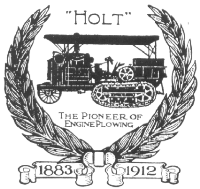 The company's first logo as it appeared on a 25th anniversary sales brochure | |
| Company type | Private company |
|---|---|
| Industry | Agricultural machinery, construction |
| Predecessor | Holt Bros. Manufacturing |
| Founded | 1883 (Stockton Wheel Service) January 7, 1892 (Holt Manufacturing Company) Stockton, California, United States |
| Founder | Ames Holt, Benjamin Holt Charles Holt, William Holt |
| Defunct | April 15, 1925 |
| Fate | Merged with C. L. Best Tractor Company |
| Successor | Caterpillar Tractor Company |
| Headquarters | , United States |
Area served | United States, Canada, Europe |
Key people | Benjamin Holt, founder and President; Charles Holt, founder; Clarence Leo Best |
Number of employees | 2,100 (1918)[1]: 64 |
| Subsidiaries | Aurora Engine Company Best Manufacturing Company Canadian Holt Company, Limited Holt Caterpillar Company Holt Manufacturing Company Houser and Haines Manufacturing Company Stockton Wheel Co. |
| Footnotes / references [2][3] | |


The Holt Manufacturing Company began with the 1883 founding of Stockton Wheel Service in Stockton, California, United States.[3][4][5] Benjamin Holt, later credited with patenting the first workable crawler ("caterpillar") tractor design, incorporated the Holt Manufacturing Company in 1892.[6] Holt Manufacturing Company was the first company to successfully manufacture a continuous track tractor ( Hornsby in England manufactured at least two full length "track steer" machines, and their patent was later purchased by Holt in 1913, allowing Holt to claim to be the "inventor" of the crawler tractor.) By the early 20th century, Holt Manufacturing Company was the leading manufacturer of combine harvesters in the US, and the leading California-based manufacturer of steam traction engines.[7]
Holt Manufacturing Company operated from Stockton, California, until opening a satellite facility in Walla Walla, Washington, to serve the Pacific Northwest. In 1909 Holt Manufacturing Company expanded by purchasing the facility of defunct farm implement maker Colean Manufacturing Company in East Peoria, Illinois.[8] Holt changed the name of the company to Holt Caterpillar Company, although he did not trademark the name Caterpillar until 1910.[9]
The company's initial products focused on agricultural machinery and were distributed internationally. During World War I, almost all of its production was military materiel. Its tractors were widely used by the Allies to supplant horses pulling haul heavy artillery and tow supply trains. Holt tractors also played a part, to varying degrees, in the development of military tanks in Great Britain, France, and Germany. Holt's equipment was credited with helping the Allies to win the war.[10]
As the war ended, the Holt company was left with huge surplus inventories of heavy-duty tractors ill-suited for the agricultural market, which had been dominated during the war by the Holt Company's primary competitor, C. L. Best. The company decided to focus instead on heavy construction equipment and sought to capitalize on the passage of the Federal Aid Highway Act of 1921. Laden with debt and needing more capital to switch its product line, the company struggled to move forward.
Both the Holt Manufacturing Company and C. L. Best were hurt by the depression of 1920–21 which further inhibited sales. Both companies streamlined their over-lapping product lines. The two companies had spent about US$1.5 million (about $26,060,721 today) in legal fees fighting each other in various contractual, trademark, and patent infringement lawsuits since 1905. On the advice of investors, the two companies merged in 1925 to form the Caterpillar Tractor Co. As of 2010[update], Caterpillar Inc. was the 229th largest company in the world.
- ^ Cite error: The named reference
leffingwellwas invoked but never defined (see the help page). - ^ "Caterpillar On-Highway Engines: About Us>History>Growth". ohe.cat.com. Caterpillar Inc. 2007. Archived from the original on August 4, 2007. Retrieved February 24, 2010.
The Holt Company manufactured their own gasoline engines at the original "engine division," the Aurora Engine Company,...a subsidiary company set up for that purpose.
- ^ a b Harte, Bret (August 1902). "The Greatest Motor Machine". The Overland Monthly. XL (2). San Francisco, California, United States: Frederick Marriott: 196. Archived from the original on January 3, 2014. Retrieved November 9, 2010.
The Holt Bros. Manufacturing concern of Stockton was established in 1883, first making reputation for its famous Stockton Wheels [sic]
- ^ "Stockton Wheel Service". stocktonwheel.com. Stockton Wheel Service. 2005. Archived from the original on July 16, 2011. Retrieved December 6, 2010.
In 1883 the business was moved to Stockton, California....In 1892, The Company was incorporated as Holt Manufacturing Company and Stockton Wheel Company...
- ^ Cite error: The named reference
orlemanwas invoked but never defined (see the help page). - ^ Cite error: The named reference
aboutwas invoked but never defined (see the help page). - ^ Haycraft, William R. (August 7, 2002). "The Beginnings 1831–1945". Yellow Steel: The Story of the Earthmoving Equipment Industry (First paperback ed.). United States of America: University of Illinois Press. p. 50. ISBN 978-0-252-07104-1. Archived from the original on January 3, 2014. Retrieved November 9, 2010.
...the nation's leading manufacturer of combines and California's largest producer of steam traction engines at the turn of the [20th] century.
- ^ Haycraft, William R. (August 7, 2002). "The Beginnings 1831–1945". Yellow Steel: The Story of the Earthmoving Equipment Industry (First paperback ed.). United States of America: University of Illinois Press. p. 52. ISBN 978-0-252-07104-1. Archived from the original on January 3, 2014. Retrieved November 9, 2010.
Until 1909 Holt's operations were centered in Stockton, with a small branch in Walla Walla, Washington...
- ^ Cite error: The named reference
acmoc2was invoked but never defined (see the help page). - ^ Ellis, C. & Bishop, D. Military Transport of World War I Blandford Press, 1976, pp 135-6
